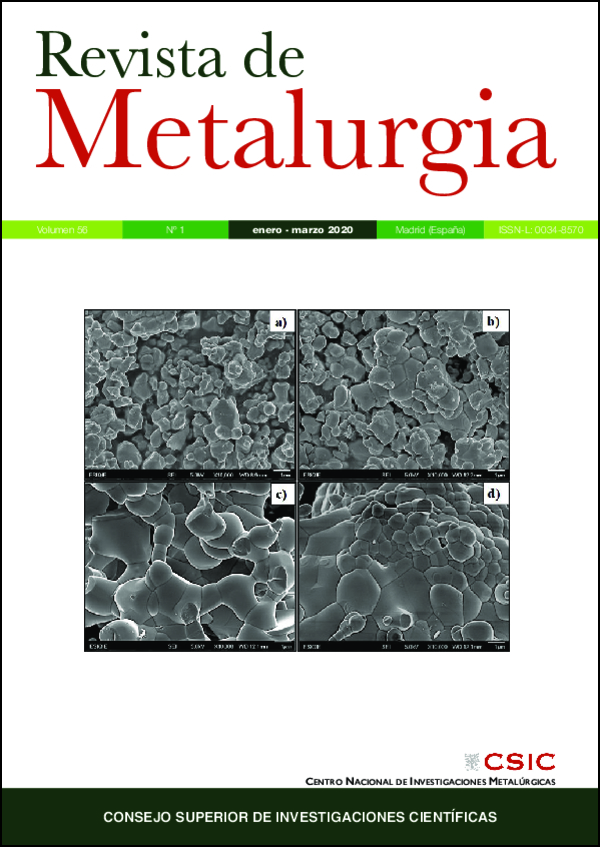La eliminación de metales tóxicos presentes en efluentes líquidos mediante resinas de cambio iónico. Parte XII: Mercurio(II)/H+/Lewatit SP112
DOI:
https://doi.org/10.3989/revmetalm.160Palabras clave:
Efluentes líquidos, Eliminación, Lewatit SP112, Mercurio(lI), Nanotubos de carbono de pared múltipleResumen
El mercurio(II) puede ser eliminado de disoluciones acuosas acidas mediante la resina de intercambio catiónico Lewatit SP112. Se ha investigado la influencia de distintas variables experimentales sobre la carga del mercurio(II) en la resina: velocidad de agitación (275–1000 min−1), temperatura (20–60 °C), valor de pH del medio acuoso (0–4) y dosificación de la resina (0.05–0.4 g·L−1). La carga de mercurio(II) en la resina disminuye con el aumento de la temperatura (reacción exotérmica) en un proceso espontaneo, mientras que el modelo de núcleo recesivo representa al mecanismo de carga del metal en el rango de temperaturas investigado. Los datos experimentales se ajustan al modelo cinético de segundo orden (275 min−1) o al modelo de pseudo segundo orden (500–1000 min−1), aunque la carga máxima del metal en la resina no depende de la velocidad de agitación. Los datos experimentales se ajustan a la isoterma tipo-2 de Langmuir. Se ha comparado la carga de mercurio(II) con distintas resinas y con nanotubos de carbono de pared múltiple. El mercurio(II) puede ser eluido con distintos eluyentes, pudiéndose obtener mercurio en estado de oxidación 0 a partir de las disoluciones de elución conteniendo al Hg(II).
Descargas
Citas
Alguacil, F.J., Coedo, A.G., Dorado, T., Padilla, I. (2002). The removal of toxic metals from liquid effluents by ion exchange resins. Part I: chromium(VI)/sulphate/Dowex 1×8. Rev. Metal. 38 (4), 306-311. https://doi.org/10.3989/revmetalm.2002.v38.i4.412
Alguacil, F.J. (2002). The removal of toxic metals from liquid effluents by ion exchange resins. Part II: cadmium(II)/sulphate/Lewatit TP260. Rev. Metal. 38 (5), 348-352. https://doi.org/10.3989/revmetalm.2002.v38.i5.418
Alguacil, F.J. (2003). The removal of toxic metals from liquid effluents by ion exchange resins. Part III: copper(II)/sulphate/Amberlite 200. Rev. Metal. 39 (3), 205-209. https://doi.org/10.3989/revmetalm.2003.v39.i3.330
Alguacil, F.J., López, F.A., Rodriguez, O., Martinez-Ramirez, S., Garcia-Diaz, I. (2016). Sorption of indium (III) onto carbon nanotubes. Ecotox. Environ. Safe. 130, 81-86. https://doi.org/10.1016/j.ecoenv.2016.04.008 PMid:27085001
Alguacil, F.J. (2017a). The removal of toxic metals from liquid effluents by ion exchange resins. Part IV: chromium(III)/H+/Lewatit SP112. Rev. Metal. 53 (2), e093.
Alguacil, F.J. (2017b). The removal of toxic metals from liquid effluents by ion exchange resins. Part V: nickel(II)/H+/Dowex C400. Rev. Metal. 53 (4), e105.
Alguacil, F.J. (2018a). The removal of toxic metals from liquid effluents by ion exchange resins. Part VI: manganese(II)/H+/Lewatit K2621. Rev. Metal. 54 (2), e116.
Alguacil, F.J. (2018b). The removal of toxic metals from liquid effluents by ion exchange resins. Part VII: manganese(VII)/H+/Amberlite 958. Rev. Metal. 54 (3), e125.
Alguacil, F.J., Escudero, E. (2018). The removal of toxic metals from liquid effluents by ion exchange resins. Part VIII: arsenic(III)/OH-/Dowex 1x8. Rev. Metal. 54 (4), e132.
Alguacil, F.J. (2019a). The removal of toxic metals from liquid effluents by ion exchange resins. Part IX: lead(II)/H+/Amberlite IR-120. Rev. Metal. 55 (1), e138.
Alguacil, F.J. (2019b). The removal of toxic metals from liquid effluents by ion exchange resins. Part X: antimony(III)/H+/Ionac SR7. Rev. Metal. 55 (3), e152.
Alguacil, F.J. (2019c). The removal of toxic metals from liquid effluents by ion exchange resins. Part XI: cobalt(II)/H+/Lewatit TP260. Rev. Metal. 55 (4), e154.
Haghdoost, Gh., Aghaie, H., Monajjemi, M. (2017). Investigation of Langmuir and Freundlich Adsorption Isotherm of Co2+ Ion by Micro Powder of Cedar Leaf. Orient. J. Chem. 33 (3), 1569-1574. https://doi.org/10.13005/ojc/330363
Ho, Y.-S. (2006). Review of second-order models for adsorption systems. J. Hazard. Mater. 136 (3), 681-689. https://doi.org/10.1016/j.jhazmat.2005.12.043 PMid:16460877
Fu, Y., Sun, Y., Chen, Z., Ying, S., Wang, J., Hu, J. (2019). Functionalized magnetic mesoporous silica/poly(m-aminothiophenol) nanocomposite for Hg(II) rapid uptake and high catalytic activity of spent Hg(II) adsorbent. Sci. Total Environ. 691. 664-674. https://doi.org/10.1016/j.scitotenv.2019.07.153 PMid:31325865
López Diaz-Pavon, A., Cerpa, A., Alguacil, F.J. (2014). Processing of indium(III) solutions via ion exchange with Lewatit K-2621 resin. Rev. Metal. 50 (2), e010. https://doi.org/10.3989/revmetalm.010
USGS (2019). Mercury Statistics and Information. Mineral Commodity Summaries, US Geological Survey. (Accesed July 2019) www.usgs.gov/centers/nmic/mercury-statistics-and-information.
Publicado
Cómo citar
Número
Sección
Licencia
Derechos de autor 2020 Consejo Superior de Investigaciones Científicas (CSIC)

Esta obra está bajo una licencia internacional Creative Commons Atribución 4.0.
© CSIC. Los originales publicados en las ediciones impresa y electrónica de esta Revista son propiedad del Consejo Superior de Investigaciones Científicas, siendo necesario citar la procedencia en cualquier reproducción parcial o total.
Salvo indicación contraria, todos los contenidos de la edición electrónica se distribuyen bajo una licencia de uso y distribución “Creative Commons Reconocimiento 4.0 Internacional ” (CC BY 4.0). Consulte la versión informativa y el texto legal de la licencia. Esta circunstancia ha de hacerse constar expresamente de esta forma cuando sea necesario.
No se autoriza el depósito en repositorios, páginas web personales o similares de cualquier otra versión distinta a la publicada por el editor.
















